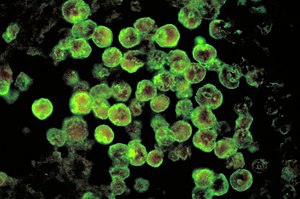Naegleriasis
| Naegleriasis | |
|---|---|
| Synonyms | primary amoebic meningoencephalitis (PAM), amebic encephalitis, naegleria infection, amoebic meningitis |
 |
|
| Histopathology of primary amebic meningoencephalitis due to Naegleria fowleri. Direct fluorescent antibody stain. | |
| Pronunciation | |
| Classification and external resources | |
| Specialty | Infectious disease |
| ICD-10 | A06.6, B60.2 |
| ICD-9-CM | 136.2 |
Naegleriasis (also known as primary amoebic meningoencephalitis) is an infection of the brain by the free-living unicellular Naegleria fowleri.
N. fowleri is typically found in warm bodies of fresh water, such as ponds, lakes, rivers, and hot springs. It is also found in soil, poorly maintained municipal water supplies, water heaters, near warm-water discharges of industrial plants, and in poorly chlorinated or unchlorinated swimming pools, in an amoeboid or temporary flagellate stage. There is no evidence of it living in salt water.
Although infection occurs rarely, it nearly always results in death, with a case fatality rate greater than 95%.
Onset of symptoms one to nine days following exposure (with an average of five). Initial symptoms include changes in taste and smell, headache, fever, nausea, vomiting, and a stiff neck. Secondary symptoms include confusion, hallucinations, lack of attention, ataxia, and seizures. After the start of symptoms, the disease progresses rapidly over three to seven days, with death occurring usually from seven to fourteen days later, although it can take longer. In 2013, a man in Taiwan died twenty-five days after being infected by Naegleria fowleri.
It affects healthy children or young adults who have recently been exposed to bodies of fresh water. Some people have presented with a clinical triad of edematous brain lesions, immune suppression, and fever.
N. fowleri invades the central nervous system via the nose, specifically through the olfactory mucosa of the nasal tissues. This usually occurs as the result of the introduction of water that has been contaminated with N. fowleri into the nose during activities such as swimming, bathing, or nasal irrigation.
...
Wikipedia
